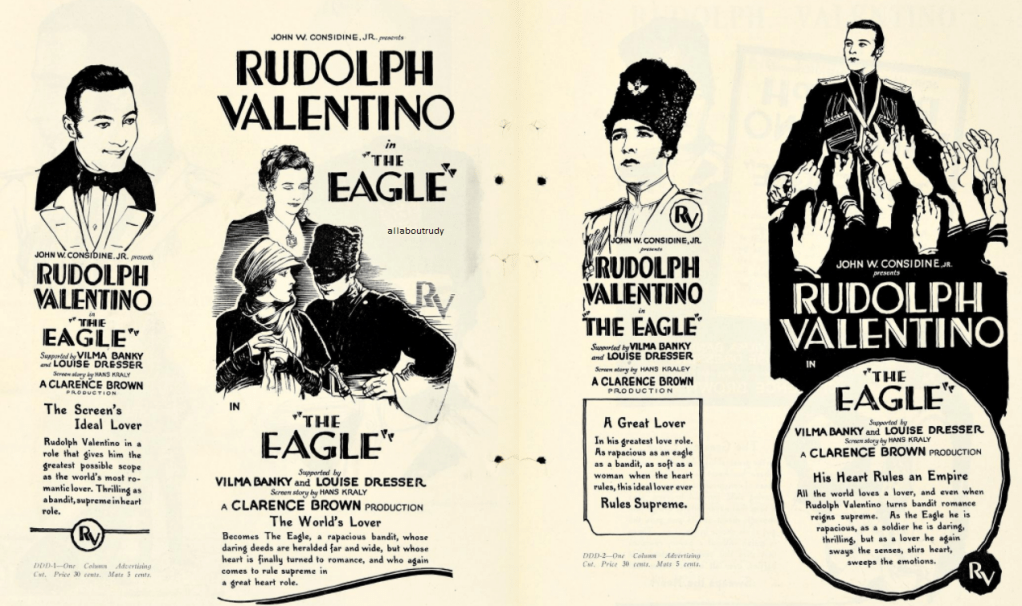
Posts Tagged With: “The Eagle”
6 Oct 1934 – Royalties Still Paid on Films of Valentino
Heirs of Rudolph Valentino are still collecting royalties from his pictures more than eight years after his death it was revealed in court today. Two of the late actors’ greatest films “Son of the Sheik” and “The Eagle” are still shown in theatres throughout the world, the administrator of his estate informed Probate Judge Walton Wood. The court was asked to approve a compromise settlement of $6,093.75 with Art Cinema corporation as royalties due to the estate. The court concurred.

12 Feb 1927 – Valentino is a Russian Hero
Will Rudolph Valentino do for the Russian what he did for the Latin? Meaning, will he make us thing of the romantic male when a Russian is mentioned? Ever since Rudy glided through “The Four Horsemen” and cut a great big niche for himself in the cinema hall of fame we have thought of Spaniards and Argentinians whenever the discussion led to heart flutters. We even think of “sheiks” as being of Latin persuasion. All of which speculation is due to the fact Valentino is appearing as a Russian in “The Eagle,” a glamorous film showing at the Liberty theater Sunday and Monday. Vilma Hanky, famous Hungarian beauty, plays opposite the star. Louise Dresser, noted stage and vaudeville star for years, has a featured role as the Czarina.
Dec 1925 – The Eagle Movie Review
In the guise of a dandy Cossack Lieutenant, who becomes an artful, gallant and very lucky bandit, Rudolph Valentino’s shadow yesterday afternoon at the Mark Strand renewed its acquaintance with admiring throngs in a production entitled “The Eagle,” which is based on Alexander Pushkin’s novel “Dubrovsky.” Following the first presentation of the film Mr. Valentino himself took the stage and thanked the audience for its reception of the picture, adding that he felt sure that by it he would regain that popularity he enjoyed a few years ago. While he admitted that his preceding photoplay, “The Sainted Devil,” was a poor picture, he refrained from referring to the picturization of Martin Brown’s play “Cobra,” which he finished before starting work on the present offering, and which has not yet been released. The Mark Strand was packed, the police were kept busy at the theatre entrance holding back the crowd, and an enthusiastic collection of people after the first show pressed around the stage entrance, watching eagerly for the screen star’s appearance on the street. Through the introduction of Catherine of Russia, or a modern conception of that lady, the initial chapters of “The Eagle” are reminiscent of the picturization of “The Czarina,” which in film form was heralded as “Forbidden Paradise.” Although these sequences in the Valentino photoplay are undeniably entertaining, they by no means reach the artistic heights achieved by Ernst Lubitsch and Pola Negri in “Forbidden Paradise.” Mr. Valentino is indeed fortunate in having obtained the services of Vilma Banky from Samuel Goldwyn, for Miss Banky is so lovely to look upon that her beauty makes the hero’s gallantry all the more convincing. In this production, which might suit several male screen celebrities, including the agile Douglas Fairbanks. Mr. Valentino acquits himself with distinction. He appears, to have benefited by Clarence Brown’s direction and to have appreciated that Miss Banky was a valuable asset to his picture. It was an excellent idea also to have Hans Kraely, Mr. Lubitsch’s clever scenarist, handle the script for “The Eagle.” Mr. Valentino first is seen in the graceful costume of a Cossack officer, his astrachan headgear often placed at a most acute angle. Subsequently he rides to romantic fame as the Black Eagle, a bandit, whose chief exploits are bowing to the fair. His lieutenants kidnap Mascha Troekouroff, impersonated by Miss Banky, only to be told by their irate chief that he does not war with women. It happens that Mascha’s cowardly father is kept on tenterhooks by the Black Eagle, who binds and gags a French tutor being sent to the Troekouroff Castle to instruct Mascha, and then impersonates the tutor, coolly reporting to the girl’s parents, who had incidentally offered 5,000 rubies reward for the Black Eagle, dead or alive. One has the satisfaction of seeing the Black Eagle massaging old Kyrilla Troekouroff with amazing energy, and then seeing the hero turn his attention to Mascha in caressing fashion. Kyrilla receives notes from the Black Eagle under his plate, and his mind is always uneasy. He is a cruel old fool; who has a chained bear in his wine cellar, and he looks upon it as a pretty jest when he sends a victim down to get a bottle of the best wine. This happens to the Black Eagle, who kills the “jest” with a bullet. Before he took up the calling of bandit, the then respectable Lieutenant Vladimir Dubrovsky had been told in private audience by the Czarina: “You are the first Russian to see his Czarina weep.” Dubrovsky had been commanded to appear in the royal presence at 6 o’clock, and it is explained that 6 o’clock meant supper and not Siberia. The young lieutenant, always so courageous, had abandoned the Czarina when she was about to mount her favorite horse, because he observed two frightened horses dashing away with a vehicle in which sat an aunt, a Pekinese and the glorious Mascha. This is a satisfying picture in which Mr. Brown introduces some interesting touches. It is well equipped with scenery and the costumes of the players are capably designed. Mascha, at a banquet, adorns herself with a wealth of pearls, and the Czarina, played by Louise Dresser, arrays herself as Commander-in-Chief of the military forces. THE EAGLE, with Rudolph Valentino, Vilma Banky, Louise Dresser, Albert Conti, James Marcus, George Nichols and Carrie Clark Ward, adapted from the novel, “Dubrovsky,” by Alexander Pushkin; directed by Clarence Brown; overture, Tschaikowsky’s “1812”;
16 Nov 1925 -The Eagle Movie Review
26 Aug 1926 – Sheik Poor Financier, Says Friend
The world’s greatest lover was the world’s poorest financier. If Rudolph Valentino had any bank balance at all when he died, it was but a few hundred dollars, his close friend, Joseph Schenck hazards. Last year the sheik earned between a million and a million and a quarter dollars and spent virtually every cent of it. There was no reverence for money in “Rudy’s” makeup. There was no bent-for its accumulation. Valentino was prodigal, gullible. If he saw something he wanted whether an automobile, a tapestry or a fishing pole he bought it, regardless of price says Schenck., head of United Artists. “I should judge his home at Hollywood was worth $75,000. He always owned four of five cars and some riding horses. “For his home, he bought many painting s and tapestries often at inflated prices. He had a collection of fencing foils, and another of guns/ “Anybody could touch him. He carried $50,000 personal insurance. Friends often advised him to increase the amount, but here again is Valentino’s disregard for money was manifest. Accumulating lasting wealth in life or leaving it in death meant nothing to him. “But for his business manager George Ullman, he might easily have died broke.” Valentino had a 50% interest in the net profits of “The Son of the Sheik” and “The Eagle.” These two pictures still are playing over the country, and the Valentino Estate doubtless will receive a comfortable amount from them. His salary from the production organization of United Artists was $6500 per week $338,000 a year. For making each of his earlier pictures of importance, Valentino generally received $200,000 and a 25% share of the profits. So far, as Schenck knows Valentino never invested in stocks or bonds and owned no real estate other than his house. Thus his estate is without “quick assets” other than his insurance. Both his parents are dead. Valentino was unusually fond of his brother Alberto Guglielmi and his sister Maria. He was devoted to Alberto’s children. To these kin, probably will go such worldly goods as failed to slip through “Rudy’s” fingers. The world’s greatest lover was the world’s poorest financier. If Rudolph Valentino had any bank balance at all when he died, it was but a few hundred dollars, his close friend, Joseph Schenck hazards. Last year the sheik earned between a million and a million and a quarter dollars and spent virtually every cent of it. There was no reverence for money in “Rudy’s” makeup. There was no bent-for its accumulation. Valentino was prodigal, gullible. If he saw something he wanted whether an automobile, a tapestry or a fishing pole he bought it, regardless of price says Schenck., head of United Artists. “I should judge his home at Hollywood was worth $75,000. He always owned four of five cars and some riding horses. “For his home, he bought many painting s and tapestries often at inflated prices. He had a collection of fencing foils, and another of guns/ “Anybody could touch him. He carried $50,000 personal insurance. Friends often advised him to increase the amount, but here again is Valentino’s disregard for money was manifest. Accumulating lasting wealth in life or leaving it in death meant nothing to him. “But for his business manager George Ullman, he might easily have died broke.” Valentino had a 50% interest in the net profits of “The Son of the Sheik” and “The Eagle.” These two pictures still are playing over the country, and the Valentino Estate doubtless will receive a comfortable amount from them. His salary from the production organization of United Artists was $6500 per week $338,000 a year. For making each of his earlier pictures of importance, Valentino generally received $200,000 and a 25% share of the profits. So far, as Schenck knows Valentino never invested in stocks or bonds and owned no real estate other than his house. Thus his estate is without “quick assets” other than his insurance. Both his parents are dead. Valentino was unusually fond of his brother Alberto Guglielmi and his sister Maria. He was devoted to Alberto’s children. To these kin, probably will go such worldly goods as failed to slip through “Rudy’s” fingers.
30 Aug 1926 – Cashing in on Death of Valentino
Desirous of meeting the public’s insistent demand for Valentino Pictures, while United Artists reported and appreciable increase of bookings on “The Eagle” which preceded “The Son of the Sheik” the late star’s last picture. In many sections of New York, exhibitors who have deemed it good showmanship to make these bookings are telling the world about it in no uncertain terms through the mediums of special marquee banners. The usual theater mailing lists are being worked plentifully in an effort to cash in on Valentino’s death.
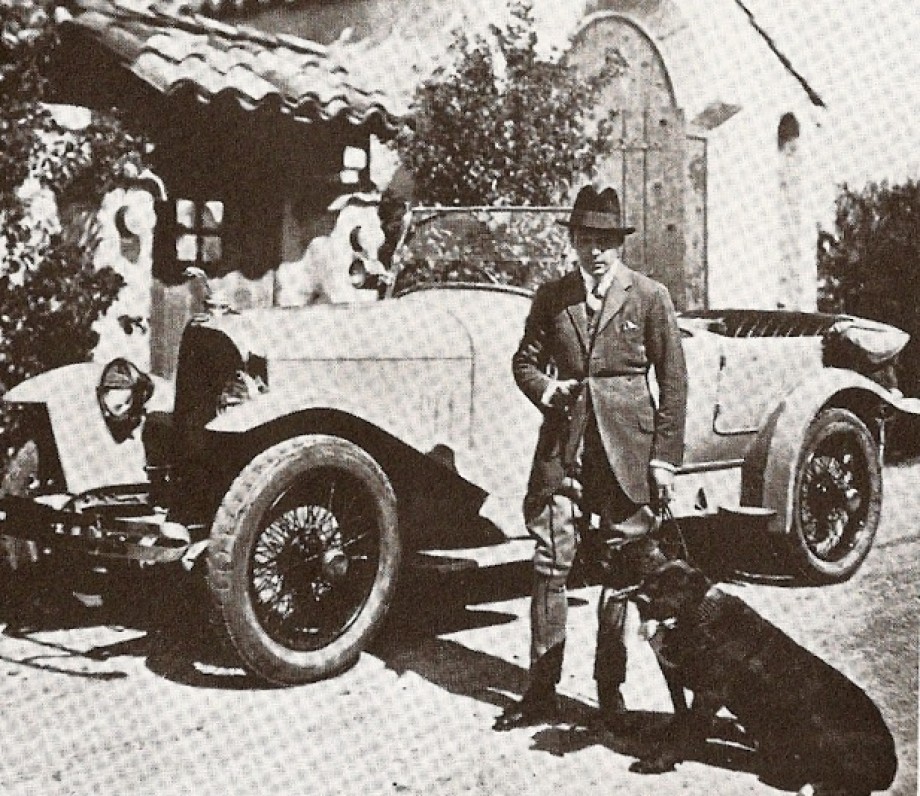
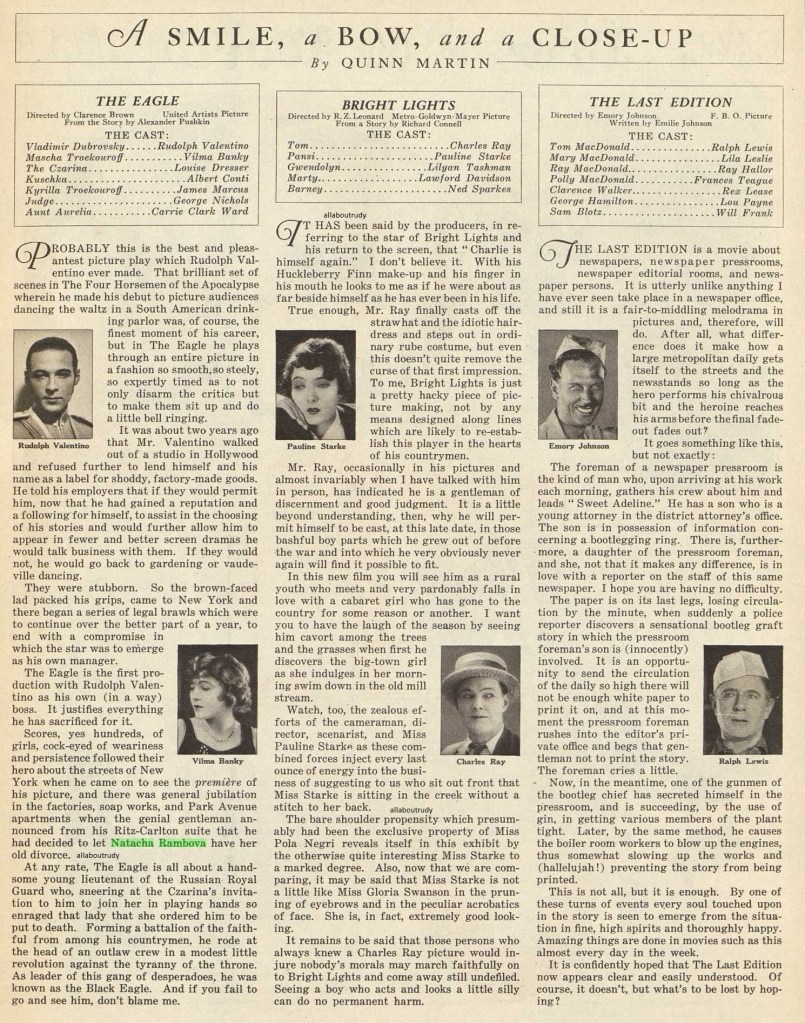
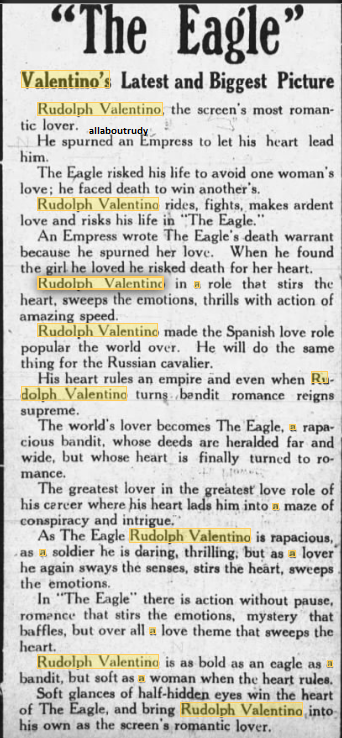



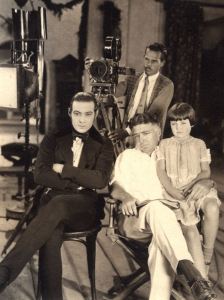
You must be logged in to post a comment.